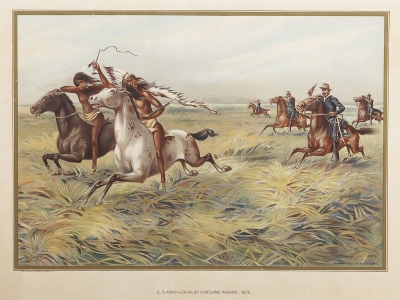Sitting Bull (Lakota: Tatka yotake [tatka i.jtak]; c.1831 December 15, 1890) was a Hunkpapa Lakota leader who led his people during years of resistance against United States government policies. He was killed by Indian agency police on the Standing Rock Indian Reservation during an attempt to arrest him, at a time when authorities feared that he would join the Ghost Dance movement.Before the Battle of the Little Bighorn, Sitting Bull had a vision in which he saw many soldiers, "as thick as grasshoppers," falling upside down into the Lakota camp, which his people took as a foreshadowing of a major victory in which many soldiers would be killed. About three weeks later, the confederated Lakota tribes with the Northern Cheyenne defeated the 7th Cavalry under Lt. Col. George Armstrong Custer on June 25, 1876, annihilating Custer's battalion and seeming to bear out Sitting Bull's prophetic vision. Sitting Bull's leadership inspired his people to a major victory. In response, the U.S. government sent thousands more soldiers to the area, forcing many of the Lakota to surrender over the next year. Sitting Bull refused to surrender, and in May 1877, he led his band north to Wood Mountain, North-Western Territory (now Saskatchewan). He remained there until 1881, at which time he and most of his band returned to U.S. territory and surrendered to U.S. forces.
After working as a performer with Buffalo Bill's Wild West show, Sitting Bull returned to the Standing Rock Agency in South Dakota. Due to fears that he would use his influence to support the Ghost Dance movement, Indian Service agent James McLaughlin at Fort Yates ordered his arrest. During an ensuing struggle between Sitting Bull's followers and the agency police, Sitting Bull was shot in the side and head by Standing Rock policemen Lieutenant Bull Head (Tatankapah, Lakota: Tatka P) and Red Tomahawk (Marcelus Chankpidutah, Lakota: hap Dta), after the police were fired upon by Sitting Bull's supporters. His body was taken to nearby Fort Yates for burial. In 1953, his Lakota family exhumed what were believed to be his remains, reburying them near Mobridge, South Dakota, near his birthplace.
The American Indian Wars, also known as the American Frontier Wars, the First Nations Wars in Canada (French: Guerres des Premières Nations), and the Indian Wars, were fought by European governments and colonists in North America, and later by the United States and Canadian governments and American and Canadian settlers, against various American Indian and First Nation tribes. These conflicts occurred in North America from the time of the earliest colonial settlements in the 17th century until the early 20th century. The various wars resulted from a wide variety of factors. The European powers and their colonies also enlisted allied Indian tribes to help them conduct warfare against each other's colonial settlements. After the American Revolution, many conflicts were local to specific states or regions and frequently involved disputes over land use; some entailed cycles of violent reprisal.
As settlers spread westward across North America after 1780, armed conflicts increased in size, duration, and intensity between settlers and various Indian and First Nation tribes. The climax came in the War of 1812, when major Indian coalitions in the Midwest and the South fought against the United States and lost. Conflict with settlers became much less common and was usually resolved by treaty, often through sale or exchange of territory between the federal government and specific tribes. The Indian Removal Act of 1830 authorized the American government to enforce Indian removal from east of the Mississippi River to Indian Territory west on the American frontier, especially what became Oklahoma. The federal policy of removal was eventually refined in the West, as American settlers kept expanding their territories, to relocate Indian tribes to reservations.

1877May, 5
American Indian Wars: Sitting Bull leads his band of Lakota into Canada to avoid harassment by the United States Army under Colonel Nelson Miles.
Choose Another Date
Events on 1877
- 20Feb
Swan Lake
Tchaikovsky's ballet Swan Lake receives its premiere at the Bolshoi Theatre in Moscow. - 10May
Mihail Kogălniceanu
Romania declares itself independent from the Ottoman Empire following the Senate adoption of Mihail Kogălniceanu's Declaration of Independence. - 10Jul
Mayagüez, Puerto Rico
The then-villa of Mayagüez, Puerto Rico, formally receives its city charter from the Royal Crown of Spain. - 5Oct
Nez Perce people
Chief Joseph surrenders his Nez Perce band to General Nelson A. Miles. - 21Nov
Phonograph
Thomas Edison announces his invention of the phonograph, a machine that can record and play sound.

 English
English  español
español  français
français  português
português  русский
русский  العربية
العربية  简体中文
简体中文 